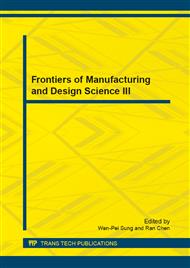p.177
p.182
p.186
p.190
p.197
p.204
p.208
p.212
p.218
Study on a Novel Form-Stable Capric Acid/Organophilic Montmorillonite Composite for Thermal Energy Storage
Abstract:
A novel form-stable capric acid/organophilic montmorillonite composite for thermal energy storage is developed in this study. The morphology and thermal properties were determined by scanning electron microscope(SEM), polarized optical microscope(POM), differential scanning calorimetry(DSC) and thermogravimetric analyzer(TGA). The DSC results showed that the on-set temperature of the sample with 40% wt CA was closed to 29°C, the latent heat was 35.8 J/g at 56 kPa and 51.5 J/g at 0 kPa, while the on-set temperature of sample with 60% CA was also 29°C, the latent heat was 79.7 J/g at 56 kPa and 80.8 J/g at 0 kPa. TG investigations revealed that the composites had excellent thermal stability above their working temperature ranges. The POM images exhibited phase behaviors of composites to confirm leakage, and the samples with 20% and 40% CA showed good thermal properties. In addition, SEM images presented the microstructure of all the samples. All of the conclusions indicated that sample with 40% wt CA was a better candidate for novel form-stable CA/OMMT composite for low-temperature thermal energy storage applications.
Info:
Periodical:
Pages:
197-203
Citation:
Online since:
December 2012
Authors:
Price:
Сopyright:
© 2013 Trans Tech Publications Ltd. All Rights Reserved
Share:
Citation:


